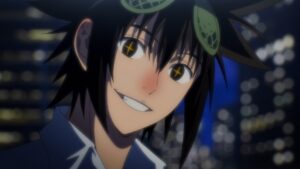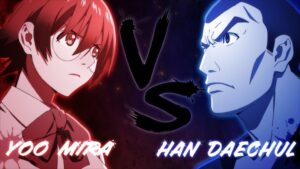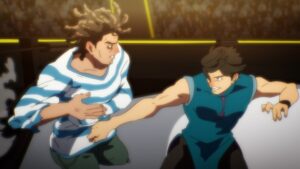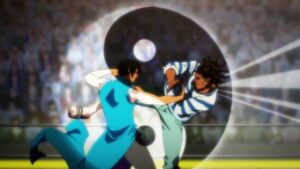The God of High School is far from my usual blogging fare. I’m not averse to action series by any means (Dorohedoro is one of my favorite anime of 2020 so far), but something so brashly combat-driven would usually fall outside my strike zone. And yet, I can’t deny the raw energy on display here, which stems mainly from the fight animation. After just two episodes, the list of ADs and studios providing 2nd key animation already spans plenty of virtual parchment, and it’s easy to see where their efforts are going. GoH’s lawless brawls are fast and furious, accounting for 90% of the show’s highlights thus far – but there’s a bit more to the show’s structure than endless martial arts matchups.
For one thing, I love that God of High School has planted its roots in the present, alluding to the characters’ pasts without making use of extended flashbacks. Our starry-eyed shounen hero Mori clearly has a score to settle with the blond tournament overseer, but that grudge defines neither his character nor the story. In the premiere, he offhandedly remarked that he’d love a rematch with the guy, which was the first we’d heard of their acquaintance. In this episode, we get a two-second glimpse of blondie standing over an unconscious Mori, a letter of invitation next to his head. These tidbits are all we need to put together their history; GoH recognizes the purity of its protagonist’s motivation (“be the strongest”), and wisely refrains from overselling it. Daewi and Mira get the same letters of recommendation as Mori, and though Mira’s dojo-based backstory gets a bit more fleshing out than the others’, it’s all in service of their burgeoning friendship.
I know we’re only two episodes in, but that friendship is a bit thin at this point. After last week’s spectacular chase scene gave the three leads a common purpose, this week’s search for the sunken sword felt a lot less purposeful. That’s probably because Mori was the one who knocked it into the river in the first place, so his offer to help with its retrieval should have been basic decency, rather than the grand gesture it became on screen. Honestly, though, I think it’s fine that the characters aren’t gelling yet. Mori is the kind of wild card who disappears from a waiting room without his new friends noticing and jumps to the defense of a guy he’s just met. That unpredictability works because Daewi and Mira don’t have a handle on him yet, and neither do we. This isn’t the kind of shounen that puts you inside the protag’s head while they grind their teeth and meditate on the villain’s cruelty for 90 seconds. This is the kind of shounen that will throw you into a fight at a moment’s notice to match its hero’s impulsivity.
Speaking of getting thrown into fights against villains, holy cow, were Manseok’s matches brutal. As the episode went on and the preliminary matches concluded in rapid succession, I grew concerned that the spectacle of the premiere wouldn’t be duplicated here. Needless to say, that fear was unfounded – the Gamdo/Manseok fight may have played out exactly the way we expected it to, but it looked damn good doing it. Tomokazu Sugita gave a positively gleeful performance as Manseok, with rumbling cackles that signaled his pleasure at crushing a proud competitor. The practice of non-intrusive flashbacks I mentioned earlier was applied to both this scene and the Mori/Manseok showdown that followed, too, giving context for the rage on display in each case. As it turns out, Manseok had the misfortune of encountering a much less friendly overseer than Mori: a blue-haired dude possessing both strength and sadism in extreme measure.
Manseok’s prior defeat links him to one of the show’s central mysteries: a supernatural force called “charyeok,” which he pursues as a means of gaining strength. The same term is uttered during the episode’s cold open, as well, in reference to the giant handprint on the private island from the premiere. And then there’s the cross-shaped tattoo visible on both that handprint and the palm of Park Mujin, Korean government official and head of the GoH tournament… For the time being, I’m content to let the show throw around these techniques and symbols without explanation; I’m here for the fights and the snappy direction, not the lore. Still, I’m confident that God of High School’s hazier story points will be addressed in due time. It’s certainly not a coincidence that both installments have opened with scenes involving Mujin, rather than Mori or other comparatively low-level fighters. The tournament we’re currently involved in is a small piece of a much larger puzzle, and while I’m interested in learning the bigger picture, the show’s next martial arts rumble is number one on my list of priorities.




